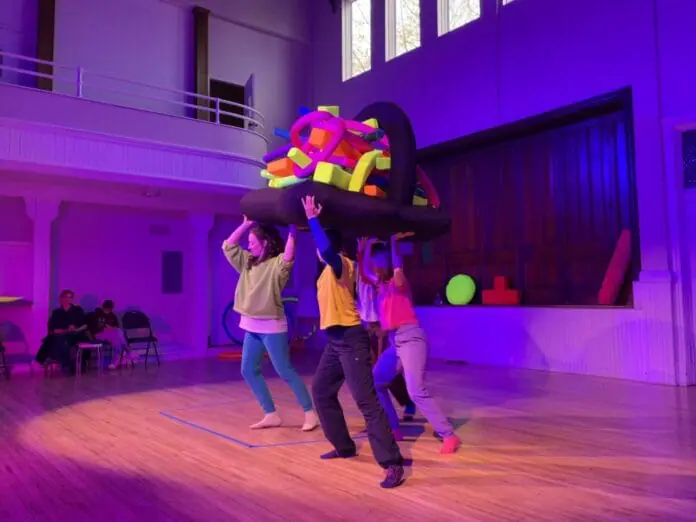It’s Nov. 4 and PLAY, a performance choreographed by Jacinte Armstrong, is taking the stage in All Nations Church. It comes complete with creaking floors and the smell of old wood.
The church is transformed by the sheer amount of colour that fills the room, as it’s flooded with purple and orange light that falls on the neon foam props stacked in four piles.
Before the performance begins, there is already an air of geniality in the room. Many people seem to know each other, and there are hugs and enthusiastic conversation as people make their way to their seats. No one seems to know what to expect, and everyone is excited to see what happens.
PLAY’s purpose
The virtual program says that PLAY is a show “intended to feel like both a workshop and a performance at once.” For as much as it is a dance show, it encourages audience participation—something that can be a little daunting.
The program states the objective is to “share in the pleasures of movement and to practice thinking with our bodies in a performance setting, with all the excitement and specialness that a performance brings.”
The dancers bringing this experience to life are Jacinte Armstrong, Lauren Runions, Gillian Seaward-Boone and Camille-Zoé Valcourt-Synnott. All are experienced artists and dancers who have come together to share this exploratory work.
An hour spent playing
The dancers enter the room dressed head-to-toe in neon colours. As the show begins, they walk around the space with linked arms as they explain that the next hour will be spent playing. The dancers urge people to participate, even if it’s scary. They present as one united whole, finishing each other’s sentences and moving in sync as they say, “We are prepared to perform the whole thing on our own, but it’s more fun when you join in.”
When they begin, it becomes clear quickly that the dancers really are playing. They experiment and laugh at themselves and each other. They use the foam props, prompts and music to guide their movements, and they take turns interpreting each other’s drawings, quickly welcoming the audience to join them in doing the same.
With each exercise, more people take the stage. A young boy and girl jump with their father as an elderly couple dance hand in hand. The colourful lights cast shadows on the wall of their beautiful movements and shapes.
As the show continues, people get more comfortable and confident; they start cheering for each other with “oohs” and “aahs.” Finally, everyone is onstage, working together, moving together, creating together, wherever the inspiration takes them. The laughter gets louder and more frequent until eventually, the music is hard to hear over the joy.
Audience reactions
Sangeeta Raju is one of the most enthusiastic audience members, discussing her experience after the show.
“It was so much fun,” said Raju.
As a dancer herself, Raju was looking forward to the experience as a chance to be creative and try something new.
She says she loved this piece because of all it had to offer.
“I think it was a really great way to encourage play, audience participation and also for people to feel comfortable moving and creating art because I know that sometimes it can be really intimidating.”
When they called for participation, Raju was one of the first on stage. She says the atmosphere the performers created made her feel encouraged.
“It taught me to not take myself so seriously and to be open to new experiences and have fun. We’re really fortunate that someone is thinking of these kinds of shows because this is more than a performative piece, it’s actually about community, building community, and changing and shaping the way that we interact with each other. Not just in this setting but in daily life.”
PLAY was a performance that brought people together through creativity and experimentation. The experience was as inspiring for audience members as it was for the creators, encouraging everyone to create, and most importantly—play.


Recent Comments